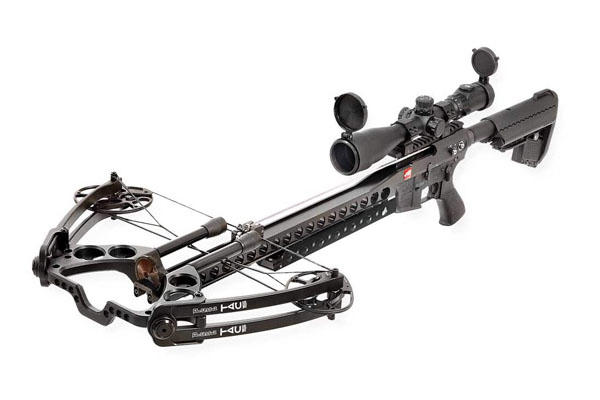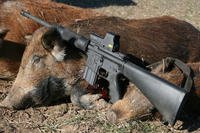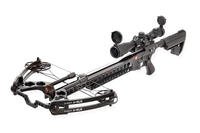The modular design of the AR rifle is a big part of its enormous popularity. By simply popping the takedown pins and switching the upper receiver assembly an AR owner can switch from a .22 long rifle or .410 shotgun used for hunting small game, on up to muscle cases like the .300 OSSM, which exceeds .308 Winchester ballistics and is capable of taking most North American big game. Now a whole new player has entered the ring.
Precision Shooting Equipment (PSE) long known for their quality archery products has thrown their hat in the AR ring by offering the Tactical Assault Crossbow or TAC-15, a crossbow that fits onto your existing AR lower assembly. PSE owner, Pete Shepley, realized the potential for such a bow to match the rising popularity of the AR-15 and the equally soaring popularity of the crossbow. Shepley challenged his designers to create a crossbow that looked like an AR-15. Shepley's engineers upped the ante by designing a crossbow that would fit onto an existing AR-15 lower receiver and incorporate its trigger and safety.
Introduced at the 2009 Archery Trade Association (ATA) and Shooting, Hunting, and Outdoors Trade (SHOT) shows, the TAC-15 has been turning heads and winning both crossbow enthusiasts and AR owners approval.
For PSE marketing director, Blake Shelby, the response is overwhelming. "Our original market was intended for existing AR enthusiasts. It is just the coolest AR accessory on the market and allows them to shoot their AR even when they don't have access to a rifle range. They can go out and practice trigger control and accuracy. Arrows are reusable so they don't have to pay as much to shoot. However, our second market is hunters. Many hunters already own AR lowers and now they can hunt with them during the archery season. For the predator hunter calling close to town, this upper is a natural. In addition, we introduced two self-controlled models that include trigger, safety, and buttstock for hunters who do not have an AR-15, but want the performance and accuracy offered by the TAC," says Shelby.
With more and more states allowing crossbows during their rifle season and many states expanding the use of crossbows during the regular archery season or holding a special season for the horizontal bow, it is time to look at crossbows in a new light.
What Makes The TAC-15 Different?
The TAC-15 differs from standard crossbows in ways other than fitting on an AR lower. "We have the technology and the ability to manufacture a crossbow unlike any on the market," says Shelby, "Using technology from our archery industry, we knew we could make a crossbow using a free floating arrow design (a nock, string loop, and arrow rest like a compound bow) to create a crossbow that was far superior to any on the market. Other manufacturers use a system that allows the string to slide along a rail. Not only is this system inefficient, robbing the limbs of energy, but the system is hard to tune. Whereas, the TAC-15 eliminates friction and is more accurate because it allows us to tune the arrow for perfect flight." claims Shelby.
All of this speed and power is developed through what PSE calls the X Tech limb system. This system forces the limbs in an outward direction canceling each other out. The limbs, with the proprietary Vibracheck backstop, which dampens all string vibration, make the TAC-15 not only one of the fastest crossbow on the market, but one of the quietest. At the end of each X Tech limb, PSE has placed an oversized cam producing a 17 3⁄4-inch power stroke capable of launching a 425-grain, 16 1⁄4-inch arrow at a blistering 412 feet per second - producing up to 160 pounds of kinetic energy. The width of the bow measures 16 3⁄4 inches axel to axel at rest and an unbelievable 11 3⁄4 inches axel to axel at full draw, making it ultra compact in the brush or on the stand.
Going Global
The TAC-15 following isn't confined to the U.S. It has been very successful, worldwide. "The original TAC was limited to countries where AR-15's were legal, but now we have the self contained versions and they have really taken off. There are many military and SWAT applications in addition to hunter and recreational shooters" claims Shelby.
Made In The USA
The entire TAC Series is manufactured in the USA with the majority of the parts produced at the PSE facility in Tucson, Arizona.
Ammunition
Unlike other crossbows, the TAC-15 shoots arrows that are more like conventional arrows rather than bolts. Due to the incredible amount of force generated by the TAC bows it requires a special arrow. The TAC- 15 arrows are 26 1⁄4 inches long and weigh 425 grains. They contain approximately three times the amount of carbon found in a normal carbon arrow.
Each arrow features a specially designed nock that is not only built to withstand the extreme velocity generated by the TAC bows, but the nock also activates a special safety feature in the Anti-Dry Firing mechanism (ADF) to prevent the shooter from dry firing or using a non-approved arrow. These arrows feature four vanes mounted at 120 degrees by 60 degrees to stabilize the arrow as it is propelled downrange.
PSE supplies shafts made by Carbon Force in packages of six for an MSRP of $89. These shafts are set up with a screw in adapter for field points or broadheads. According to Blake, the best tip weight is 100 grains.
Features Of The TAC-15
One of the most innovative features on the TAC-15 is the cocking mechanism. Unlike other crossbows that utilize foot stirrups or cumbersome cocking levers, the TAC-15's integrated cocking mechanism has a crank that requires only 12 pounds of force to cock the 170-pound peak weight.
To cock this bow, you release the ADF mechanism by engaging the ratchet-locking pin on the left side of the upper. Pull the ADF until the cord of the ADF reaches the string, and then attach it to the string loop. Next, attach the supplied crank lever to the crankshaft and wind the string back until it is cocked. Place an arrow on the string and the bow is ready to fire.
The hand crank detaches from the bow and if the shooter needs to de-cock the bow, the crank can be used to lower the string without the need to fire the bow. In addition to the ADF, the bowstring puts no bind or pressure on the AR's trigger, hammer, or sear. The TAC-15 uses the AR's trigger without increasing existing trigger pull.
PSE has also added accessory features including a free float foregrip that features a standard 1913 Mil Spec Picatinny rail to mount lights, bipods or any other tactical accessory you can dream up. Optics mount on the rail supplied with the upper, and best results are with airgun optics or conventional red dot scopes.
The bow has a machined aluminum riser and weighs in at 6.3 pounds which brings the overall weight of the bow to 8.9 pounds with lower receiver attached. Though the weight is very close to an AR, the overall length is a bit longer making it a tad front heavy, but still very manageable. Suggested retail of the TAC-15 is $1,299.
















